Platanus sp., Sycamore, London Planetree
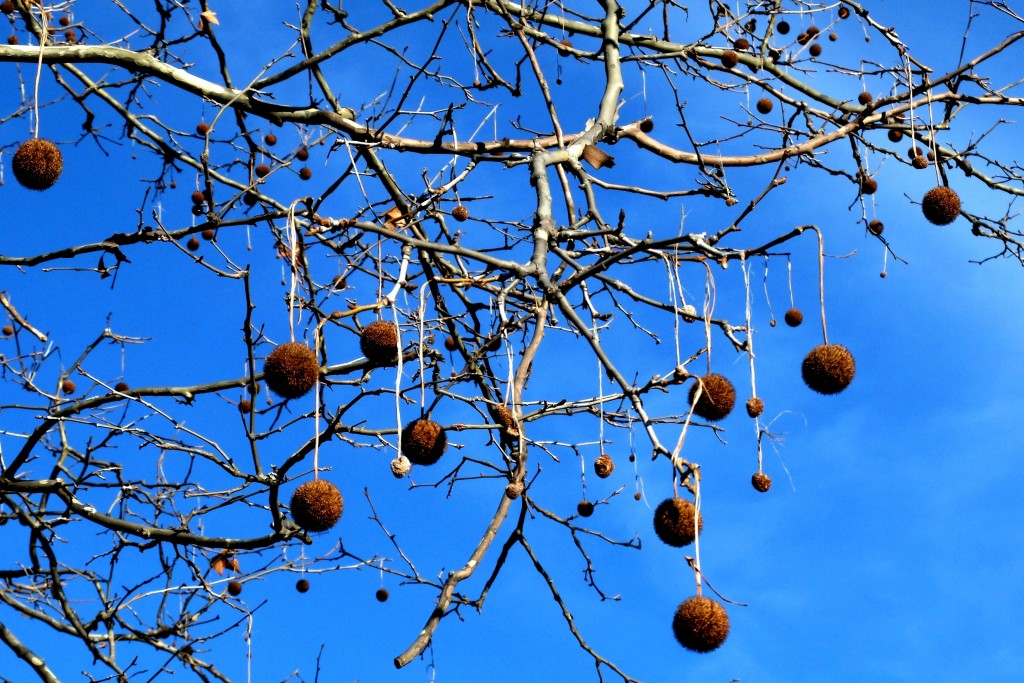
…rises bodily
into the air with
one undulant
thrust half its height-…
-William Carlos Williams
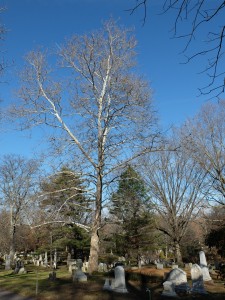 All Platanus sp., Sycamore, or London Planetree may develop in maturity into large shade trees, 70 to 100-feet in height. Knowing this adds morphological context to the above lines from Williams’ poem Young Sycamore. As the only genus within the family PLATANACEAE, these trees have family ancestors dating back 100-million years. Platanus has only ten species worldwide, one in eastern North America (Platanus occidentalis), one from southeast Europe/ southwest Asia (Platanus orientalis), one species from Laos and Vietnam, plus seven species from southwest North America and Mexico. Herein we will reference only the former two species.
All Platanus sp., Sycamore, or London Planetree may develop in maturity into large shade trees, 70 to 100-feet in height. Knowing this adds morphological context to the above lines from Williams’ poem Young Sycamore. As the only genus within the family PLATANACEAE, these trees have family ancestors dating back 100-million years. Platanus has only ten species worldwide, one in eastern North America (Platanus occidentalis), one from southeast Europe/ southwest Asia (Platanus orientalis), one species from Laos and Vietnam, plus seven species from southwest North America and Mexico. Herein we will reference only the former two species.
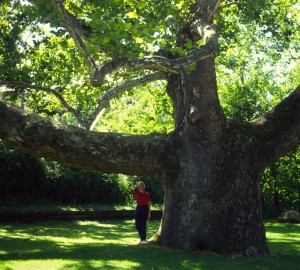 Platanus occidentalis, Sycamore is native from Maine to Minnesota, south to central Texas and Florida. Platanus is Greek for broad, and applies to the width of its leaves, occidentalis is Latin for western. This is a species able to achieve great trunk girths, larger than any other native trees in the eastern United States. Andre Michaux (1746-1802), French Royal botanist and explorer, noted for his study and collection of North American flora, wrote in the 1790’s of a Sycamore, “…the circumference of which, five feet from the earth… was forty feet four inches, which makes about thirteen feet in diameter. …Twenty years prior to my travels, George Washington had measured this same tree, and had found it nearly of the same dimensions.” Even today, along the Farmington River, in Simsbury, Connecticut, I have measured one sycamore trunk that is almost 28-feet in diameter, measured four-and –one-half-feet above the ground.
Platanus occidentalis, Sycamore is native from Maine to Minnesota, south to central Texas and Florida. Platanus is Greek for broad, and applies to the width of its leaves, occidentalis is Latin for western. This is a species able to achieve great trunk girths, larger than any other native trees in the eastern United States. Andre Michaux (1746-1802), French Royal botanist and explorer, noted for his study and collection of North American flora, wrote in the 1790’s of a Sycamore, “…the circumference of which, five feet from the earth… was forty feet four inches, which makes about thirteen feet in diameter. …Twenty years prior to my travels, George Washington had measured this same tree, and had found it nearly of the same dimensions.” Even today, along the Farmington River, in Simsbury, Connecticut, I have measured one sycamore trunk that is almost 28-feet in diameter, measured four-and –one-half-feet above the ground.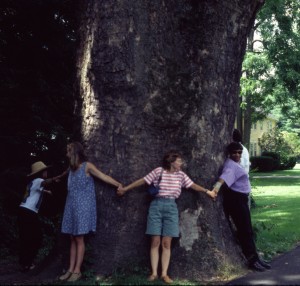
Being long-lived there have been countless massive trunked, yet hollowed-out, sycamore monarchs documented. Johnny Appleseed [John Chapman (1784-1845)] camped within a huge hollow sycamore. It was recounted of various first settlers camping within such hollows as they built their cabins. John James Audubon (1785-1851) described seeing hundreds of chimney swifts (swallows as pioneers often called them) spending a night in a hollow sycamore, “…the evening was beautiful; thousands of Swallows were flying closely above me, and three or four at a time were pitching into the hole, like bees hurrying into their hive. I remained, my head leaning on the tree, listening to the roaring noise made within by the birds… Next morning…long before daylight… The Swallows were now pouring out in a black continued stream…I estimated the time which they took in getting out at more than thirty minutes…they dispersed in every direction…”
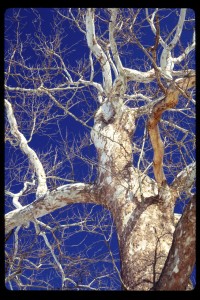 It is the polychromatic bark that most often attracts the eyes to these trees, rather than any ornamental flowers or foliage. Camouflage-like patches of gray, white, tan and green make up the beautiful upper branches of these trees. This is a result of bark flaking off in irregular patches as the tree grows in diameter. In the winter, especially against a clear, blue sky, these branches become visual beacons throughout the canopy of any and all landscapes. On youthful trees this attractive underbark may encompass the whole tree, but with maturity the lower trunks are more often gray-brown to red-brown.
It is the polychromatic bark that most often attracts the eyes to these trees, rather than any ornamental flowers or foliage. Camouflage-like patches of gray, white, tan and green make up the beautiful upper branches of these trees. This is a result of bark flaking off in irregular patches as the tree grows in diameter. In the winter, especially against a clear, blue sky, these branches become visual beacons throughout the canopy of any and all landscapes. On youthful trees this attractive underbark may encompass the whole tree, but with maturity the lower trunks are more often gray-brown to red-brown.
Platanus x acerifolia, London Planetree is a hybrid that has proven to be more urban tolerant than either of its parents. A hybrid is a plant resulting from a cross between two or more plants which are more or less alike.  London Planetree is named for the first city where it was extensively planted. Its earliest origins are not precisely scientifically documented, but it is believed to have been a naturally occurring cross first identified in Europe.
London Planetree is named for the first city where it was extensively planted. Its earliest origins are not precisely scientifically documented, but it is believed to have been a naturally occurring cross first identified in Europe.
One probable source was the South Lamberth garden of the English Tradescant family. Here briefly recounted in Stephen Spongberg’s fascinating 1990 book A Reunion of Trees, “When he returned to London from his first trip to Virginia in 1647, the younger Tradescant carried with him either seeds or vegetative propagating material of the …American Sycamore (Platanus occidentalis) and for the first time grew that species as an exotic in Europe. Meanwhile in 1633 the Tradescants had already been successful in growing the oriental plane (Platanus orientalis) having obtained seeds or plants of that tree, which is native to southeastern Europe and Asia Minor, …With the introduction of the closely related North American species into the confines of the same garden, …The two species previously separated from one another by the expanse of the Atlantic Ocean, were growing together where they might hybridize-the pollen of the oriental species functioning to fertilize the ovules concealed within the flowers of its occidental cousin, or vice versa. The resulting offspring proved unlike any tree then in existence, a tree of remarkably strong and vigorous growth…Thousands of London plane trees have been propagated from the Tradescants’ small group of originals.”
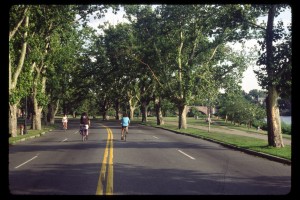 To continue we turn to noted plant explorer, author, Ernest Henry Wilson (1876-1930) from his 1930 Aristocrats of the Trees, “The most famous and most widely planted street tree in the world is, of course, the so-called London Plane (Platanus acerifolia). This pre-eminence is due to its indifference to city conditions and ability to withstand severe pruning. For the central aisle of broad thoroughfares and for embankments of river fronts it is splendid and its rapid growth is a fine asset…”
To continue we turn to noted plant explorer, author, Ernest Henry Wilson (1876-1930) from his 1930 Aristocrats of the Trees, “The most famous and most widely planted street tree in the world is, of course, the so-called London Plane (Platanus acerifolia). This pre-eminence is due to its indifference to city conditions and ability to withstand severe pruning. For the central aisle of broad thoroughfares and for embankments of river fronts it is splendid and its rapid growth is a fine asset…”
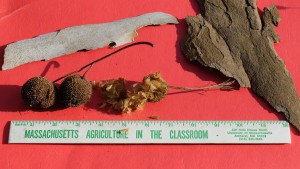 With many similarities between the two parent species and the hybrid London Planetree we can distinguish a few differences. London Planetree often will have a less creamy-white bark than either of its parents, and its pointed-lobed leaves may have deeper spaces between each lobe. Also the 1 1/2 –inch rounded fruits often occur in twos, as compared to singly with the American sycamore. These ball-shaped fruits are an aggregate of multiple seeds, which during the winter are preferred food of chickadees, juncos, purple finches, squirrels and muskrats to mention some of our wildlife that benefit from these tree.
With many similarities between the two parent species and the hybrid London Planetree we can distinguish a few differences. London Planetree often will have a less creamy-white bark than either of its parents, and its pointed-lobed leaves may have deeper spaces between each lobe. Also the 1 1/2 –inch rounded fruits often occur in twos, as compared to singly with the American sycamore. These ball-shaped fruits are an aggregate of multiple seeds, which during the winter are preferred food of chickadees, juncos, purple finches, squirrels and muskrats to mention some of our wildlife that benefit from these tree.
While we currently do not have an American sycamore growing, we do have numerous London Planetrees here. On a winter visit you will easily spot their colorful bark on Butternut Path, Crocus Path, Indian Ridge Path, off Alyssum Path, Yarrow Path, Heath Path, Acanthus Path, Olive Path, Garden Avenue, Chestnut Avenue, Glen Avenue, and Willow Pond Knoll among other locations.
Leave a Reply to Jennifer Johnston Cancel reply